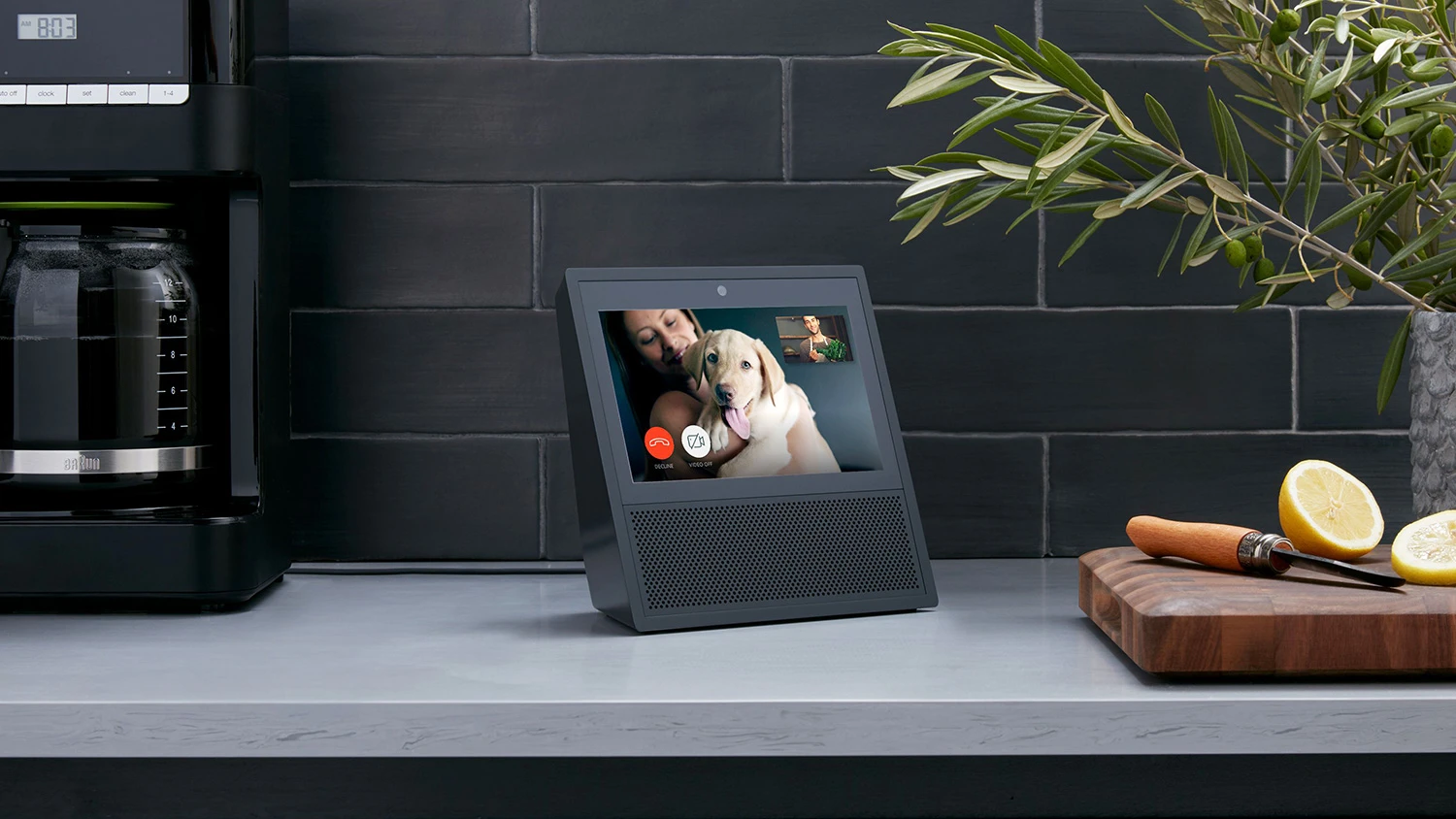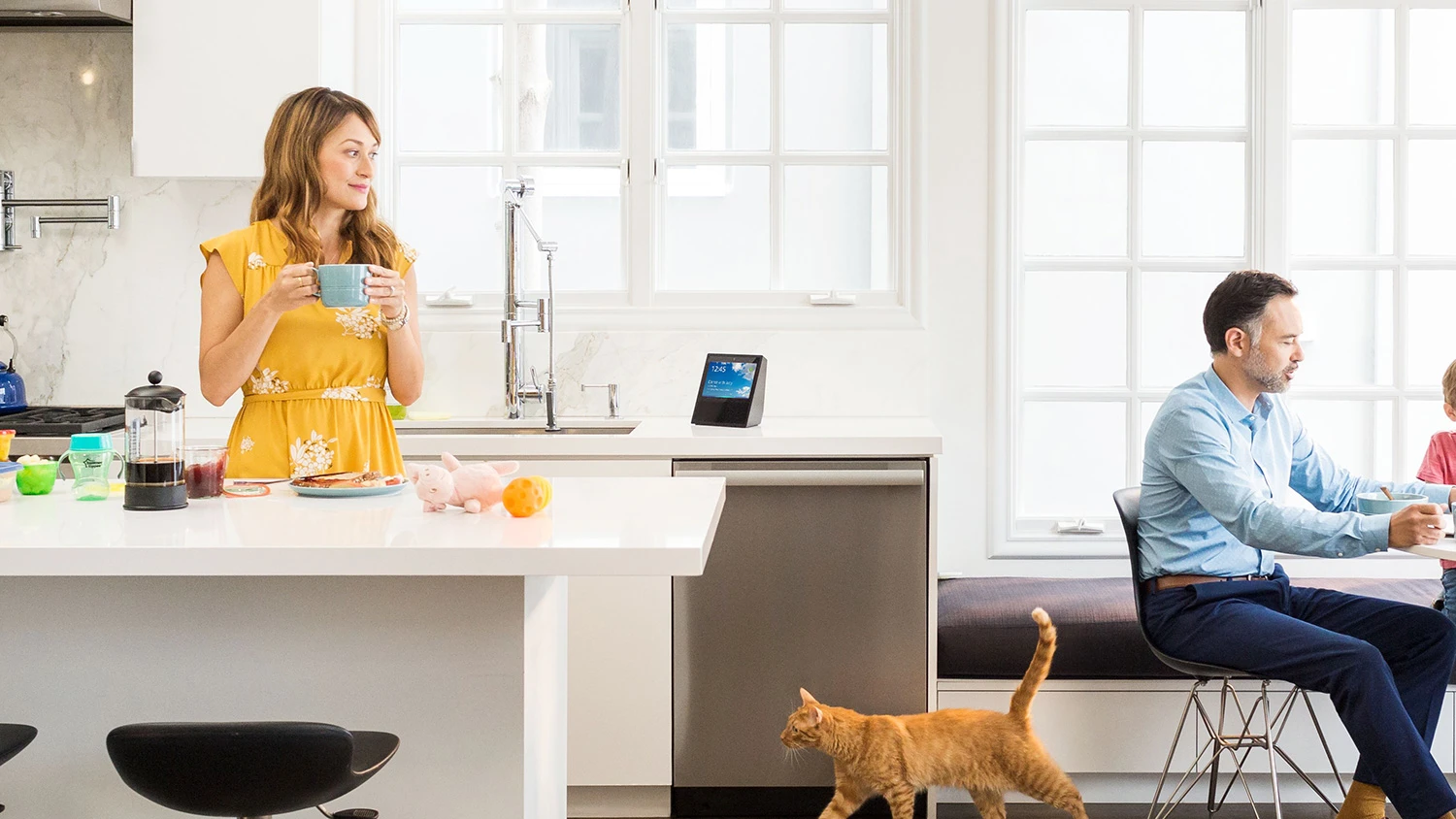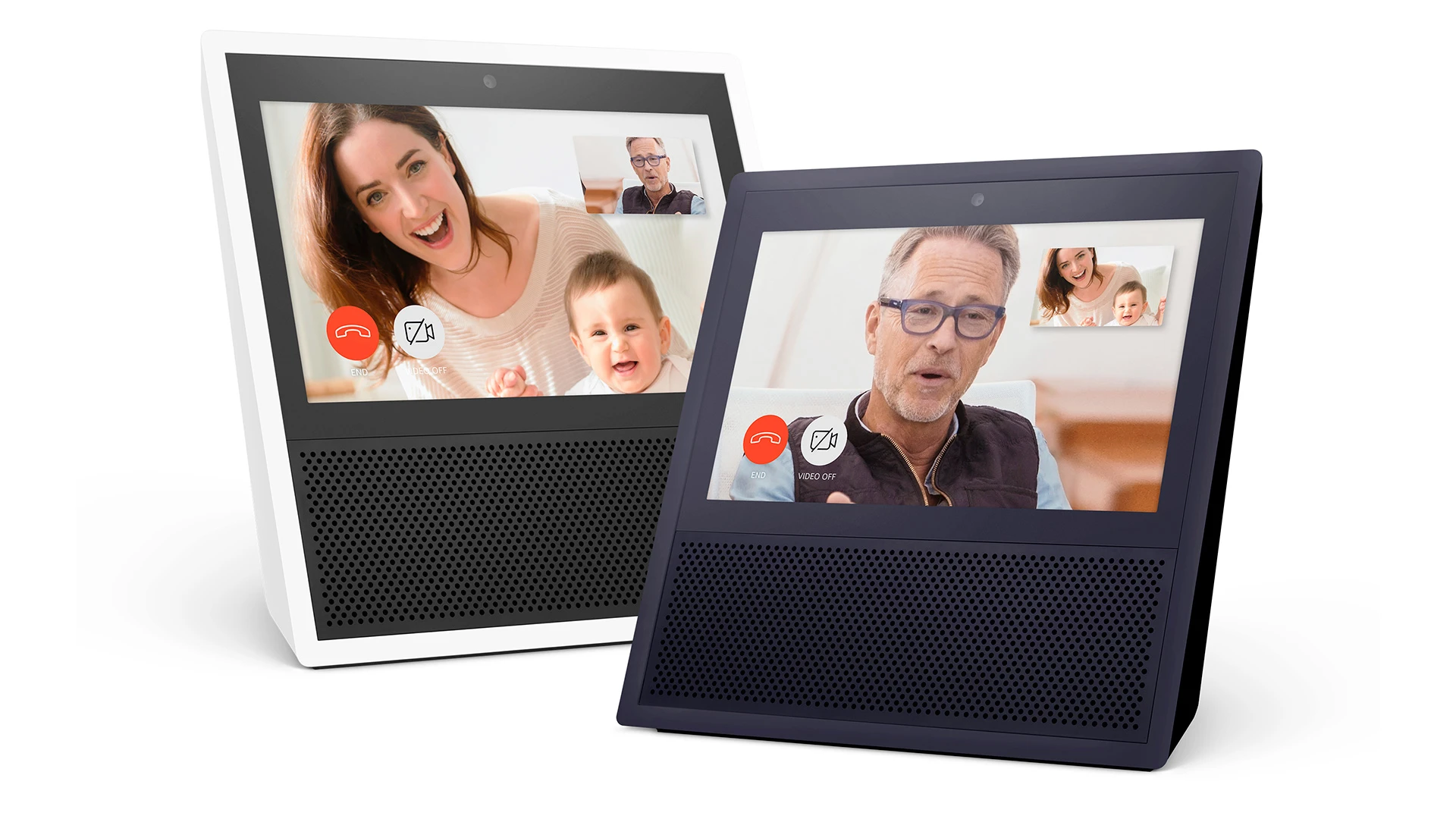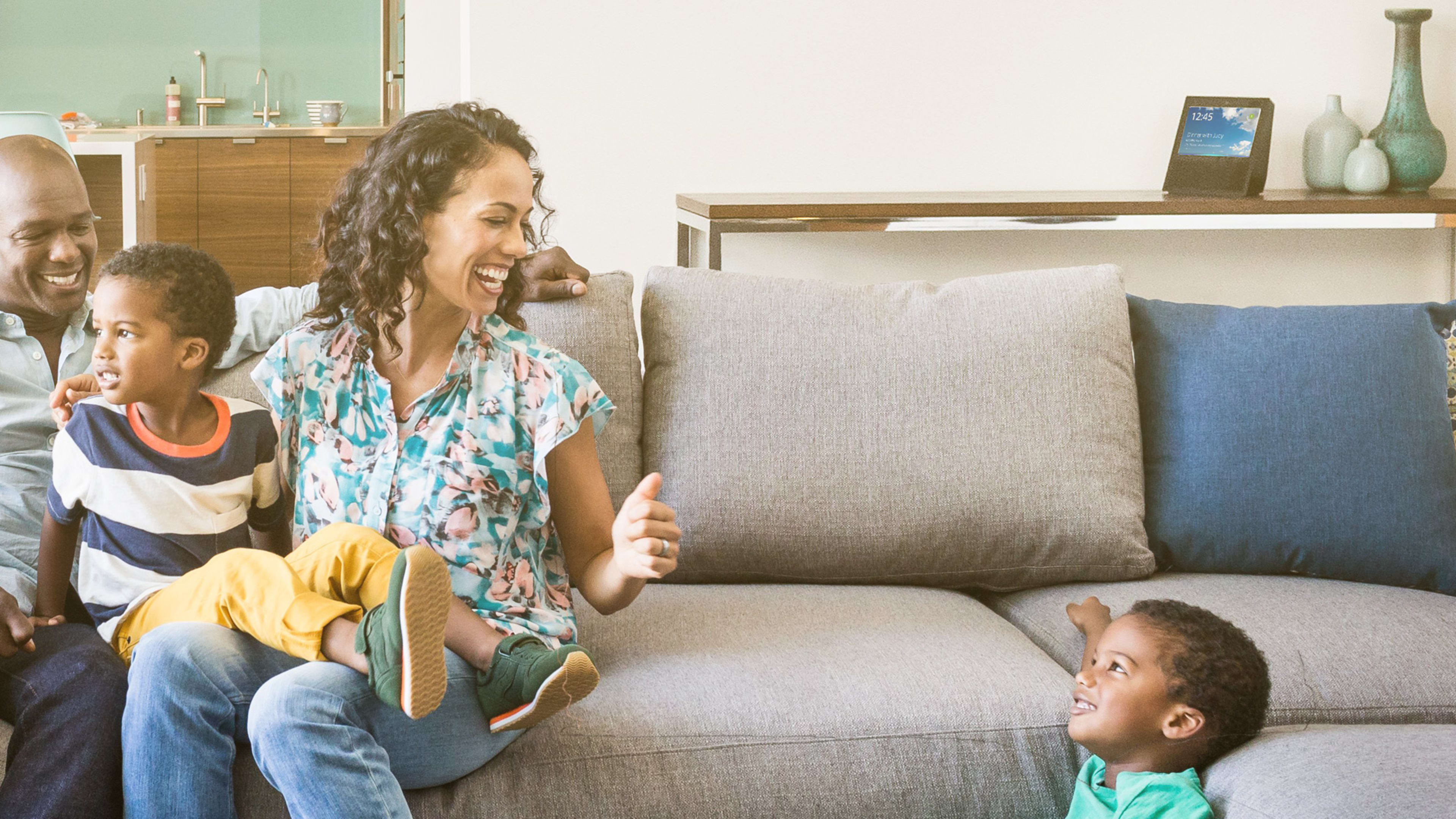This is embarrassing to admit, but I probably use Amazon’s Echo speaker to brew coffee more than anything else. Being an insufferable Aeropress snob involves precise timing while juggling a few different tasks–measuring, preheating, grinding, pouring, plunging–so asking Amazon’s Alexa assistant to set a timer tends to be easier than pulling up an app on a smartphone.
Amazon’s $230 Echo Show, which launches on Wednesday, is a fine assistant barista, with a touchscreen that can show the seconds running down. But what really sets the Echo Show apart from its screen-less siblings is how it’s coaxed me into using it as more than just a glorified kitchen timer. Whereas the Echo speaker can be easy to overlook, the Echo Show’s persistent display and front-facing video camera have a way of beckoning for your voice commands, ensuring that Alexa doesn’t get neglected.

A More Assertive Echo
While the original Echo vaguely resembles a skinny airport trash receptacle, the Echo Show looks more like a piece of the Aggro Crag, all hard edges surrounding its speaker grille and 7-inch, 1024-by-600 resolution display.
Audio quality is similar to the original Echo–loud enough to fill a large room, but lacking the oomph of a premium sound system and subwoofer–with one major distinction: The Echo Show’s speakers are stereo instead of omnidirectional, so audio becomes a bit muffled when you move behind the device. I’ve seen people put their Echo speakers on kitchen islands and bar tops, but the Echo Show might require more deliberation about how to position the screen.
The display springs into action whenever the Echo Show’s camera detects motion. The time and weather appear in the top-left corner, while the bottom half of the screen cycles through Alexa tips, upcoming calendar events, and news headlines. The subtext here is clear: Go on, start talking. Listen to some music. Watch some Amazon Prime video. Ask a question. Call a friend. Get some use out of this device for which you just paid $230.
The Echo Show has some other new ways of ingratiating itself. You can turn its home screen into a digital photo frame, either by uploading a single image through Amazon’s Alexa smartphone app or by linking to an album in Amazon Prime Photos. The device can also serve as a bedside alarm clock, with just the time displayed over a black background. Amazon’s interface even includes some cute little touches, such as lyrics for songs on Amazon Prime, and the virtual Newton’s Cradle that pops up during the final seconds of a timer.

Fundamentally, though, the Echo Show is still a voice-driven device, with no shortcuts on the home screen to any Alexa functions. At most, the touchscreen provides secondary controls for certain things such as checking off to-do list items, scrolling through Amazon product search results, and adjusting music playback.
The dependence on voice can be frustrating at times. I wouldn’t mind, for instance, a way to launch recent music playlists or Amazon Prime video episodes with just the touchscreen, or a control panel for smart home devices. But these limitations do send a message: The Echo Show is an entirely different device than your phone or tablet.
Under Alexa’s Eye
The Echo Show’s front-facing camera is more than just a motion sensor. It also supports video chat with other Echo Show devices, and with anyone who’s installed the Alexa app on iOS or Android. I tested this briefly with an Amazon representative, which at least proved that the Echo Show can handle video calls smoothly and without major glitches.
But while Amazon positions video calling as one of the Echo Show’s key features, I’m skeptical about how useful this will be in practice. The Echo Show must be plugged in for power, requiring you to stay in one spot throughout the conversation. My guess in that in most cases, a phone or tablet is going to be more practical. (Desktop PCs make you stay in place, too, but at least you can assume there will be a chair there.)

One notable exception is a feature called “drop in,” which lets trusted contacts start a video call without any confirmation from the recipient. Audio starts playing immediately during a drop in, and the recipient has about 10 seconds to end the call before video fades into view. In theory this could turn the Echo Show into a frictionless in-home intercom, or a way to keep tabs on elderly relatives, but my brief demo session didn’t give me a sense of how well this works.
On some level, I suspect video chat is more about marketing than practicality. It’s not available on other Echo devices, so it may help justify the Echo Show’s $50 premium in people’s minds even if they seldom use the feature.
The trade-off with that camera is that an all-seeing Alexa device might make some people skittish. But Amazon does offer a long list of assurances that people won’t be snooped on: The Echo Show’s camera doesn’t transmit video for anything other than video chat, and the device only sends audio to Amazon’s servers when it detects the “Alexa” wake word, which is processed on the device itself. Amazon’s “drop in” feature also requires opt-in consent from each contact, and users can disable the feature entirely or limit it to in-home intercom use. For moments of heightened paranoia, you can just tap a button atop the Echo Show to shut off its camera and microphone.
Alexa’s To-Do List
It’s worth noting that when Amazon launched the original Echo in late 2014, it could only answer basic questions, play audio from a few sources, and read the news. Smart home controls, third-party Alexa skills, and more sources of music and news came later through software updates. The Echo Show feels like it’s in a similar stage of infancy, even though it includes all the Alexa functions that Amazon has built up over the past few years.
We’ve yet to see, for instance, how third-party Alexa skills will take advantage of the screen. At the moment, they merely display a transcript of Alexa’s audio responses, but on the Alexa companion app, they’re also allowed to show an image and complementary text. The Echo Show could allow for similar visuals, and perhaps pave the way for more interactive features such as hyperlinks and scrollable lists. Amazon has already announced that smart home cameras such as the Nest Cam will be able to display a video feed on the Echo Show, so it seems likely that the company will open up the screen to more uses in the future.

It also wouldn’t be surprising if Amazon found more uses for the Echo Show’s front-facing camera, beyond just video chat and activating the display. Perhaps the motion sensor could trigger smart home devices through a service like IFTTT, or allow for the same selfie-cam capabilities as the mirror-like Echo Look.
I would never suggest buying a tech product in anticipation of unreleased or unannounced features. But even in its current state, the Echo Show succeeds at giving Alexa a stronger presence in the home. It’s worth buying over the $180 screen-less standard Echo if you can spare the extra $50 and don’t mind the lack of omnidirectional audio. And for Amazon, it’s a solid foundation for taking its virtual assistant to greater heights.
Recognize your brand’s excellence by applying to this year’s Brands That Matter Awards before the early-rate deadline, May 3.
